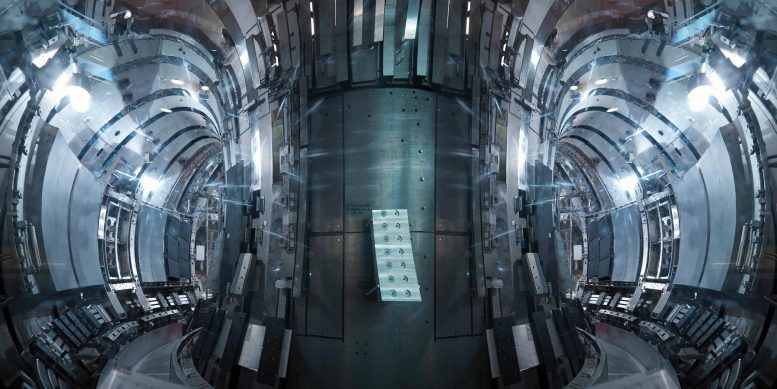
An obstacle to generating fusion reactions inside facilities called tokamaks is that producing the current in plasma that helps create confining magnetic fields happens in pulses. Such pulses, generated by an electromagnet that runs down the center of the tokamak, would make the steady-state creation of fusion energy difficult to achieve. To address the problem, physicists have developed a technique known as transient coaxial helicity injection (CHI) to create a current that is not pulsed.
Now, physicist Fatima Ebrahimi of the U.S. Department of Energy’s (DOE) Princeton Plasma Physics Laboratory (PPPL) has used high-resolution computer simulations to investigate the practicality of this technique. The simulations show that CHI could produce the current continuously in larger, more powerful tokamaks than exist today to produce stable fusion plasmas.
“Stability is the most important aspect of any current-drive system in tokamaks,” said Ebrahimi, author of a paper reporting the findings in Physics of Plasmas. “If the plasma is stable, you can have more current and more fusion, and have it all sustained over time.”

Credit: Elle Starkman / PPPL Office of Communications
Fusion, the power that drives the sun and stars, is the fusing of light elements in the form of plasma — the hot, charged state of matter composed of free electrons and atomic nuclei — that generates massive amounts of energy. Scientists are seeking to replicate fusion on Earth for a virtually inexhaustible supply of power to generate electricity.
The CHI technique replaces an electromagnet called a solenoid that induces current in today’s tokamaks. CHI produces the critical current by spontaneously generating magnetic bubbles, or plasmoids, into the plasma. The new high-resolution simulations confirm that a parade of plasmoids marching through the plasma in future tokamaks could create the current that produces the confining fields. The simulations further showed that the plasmoids would stay intact even when buffeted by three-dimensional instabilities.
In the future, Ebrahimi plans to simulate CHI startup while including even more physics about the plasma, which would provide insights to further optimize the process and to extrapolate toward next-step devices. “That’s a little bit harder,” she says, “but the news right now is that these simulations show that CHI is a reliable current-drive technique that could be used in fusion facilities around the world as they start to incorporate stronger magnetic fields.”
Reference: “Three-dimensional plasmoid-mediated reconnection and the effect of toroidal guide field in simulations of coaxial helicity injection” by F. Ebrahimi, 3 September 2019, Physics of Plasmas.
DOI: 10.1063/1.5098482
This work was supported by the DOE Office of Science (Fusion Energy Sciences). Calculations were performed in part by the National Energy Research Scientific Computing Center (NERSC), a DOE Office of Science User Facility at Lawrence Berkeley National Laboratory in Berkeley, California.
PPPL, on Princeton University’s Forrestal Campus in Plainsboro, N.J., is devoted to creating new knowledge about the physics of plasmas — ultra-hot, charged gases — and to developing practical solutions for the creation of fusion energy. The Laboratory is managed by the University for the U.S. Department of Energy’s Office of Science, which is the single largest supporter of basic research in the physical sciences in the United States and is working to address some of the most pressing challenges of our time.
5 Comments
future survival and coexist with the cosmos of humans lies in the hands of souls involved in technological advancement in science.
I know some of those words
Me too. It’s when they string them together that I get lost.
We humans are not made to live anywhere else than earth.idiots have contended that black holes are always doing something vthey shouldn’t or a new black hole that shouldn’t exist because they have no idea how the universe works. If you watch the Electric Universe you will see that the universe is electric and the sun is as well see the safire project they have allready made a star in a lab that shows energy denseties of the sun so suck it standard gravity relativity model is B’s. Its all eletrical plasma. Get over it
To Seegio:
Like David and Goliath, Humans were put here to spot celestial traffic dangers, and with hardly equal energy, find the spot to aim for and reroute asteroids, etc. and finally, when the sun gives out, find a new planet and like Jonah in the Whale, hop into rockets and like Noah, take it all elsewhere. The thing is we don’t know this, any more than the earthworm understands its indispensability to all Life. Nature operates on a need-to-know basis, and She takes no prisoners. You seem especially ignorant and hostile as well. Take cheer, and take pride in being human, and admit that for eons we have not been comfortable on Earth, and are intuitively refining the art of space travel. We are the angels here. Earth isn’t forever, but Life can be eternal, and that’s the message. Not your life, but ALL LIFE.